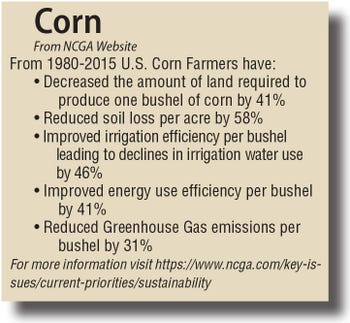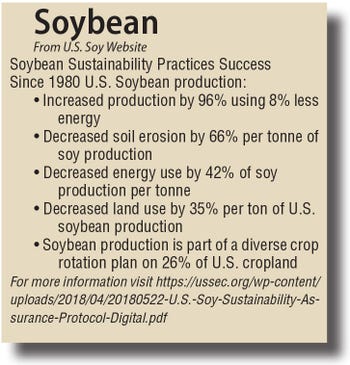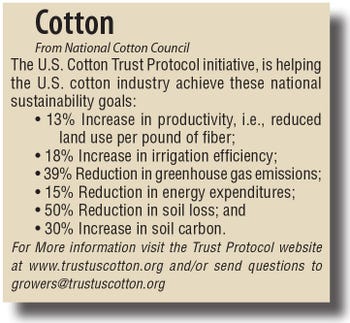
Sustainability. It’s hardwired into farmers’ DNA. Sustainable agriculture just makes sense, environmentally, economically, and aesthetically.
Successful farmers know that protecting their most valuable assets — land and water — is essential to consistent production and vital to passing farms on to following generations.
To that end, corn, cotton, and soybean farmers are employing numerous conservation strategies to preserve resources while producing good yields.
Organizations that represent these commodities, the American Soybean association, the National Corn Growers Association, and the National Cotton Council, weigh in on the importance of sustainable agriculture.
“When I started farming in 1980, no one cared much about what farmers did or how we did it,” says NCGA President John Linder. “Farmers cared. We knew that land is a finite resource. Today, everyone cares about what we do and how we produce. We have to get it right going forward. We’ve made a lot of progress since 1980. Sustainable practices produce environmental and economic benefits.”
“Brands and retailers are under growing pressure to embrace sustainability,” adds NCC President and CEO Gary Adams. “That includes proving that they are doing their part to combat climate change, which means selling products made with sustainably produced materials.”
Adams says U.S. cotton producers traditionally have led the world in innovation, quality, and responsible stewardship. “But now they understand that they must provide brands and retailers with the confidence to continue sourcing U.S. cotton.”
He says U.S. cotton farmers demonstrate a commitment to sustainability and to continuous improvement through participation in the U.S. Cotton Trust Protocol, a verifiable sustainability program.
Making the land better
ASA Economist Scott Gerlt says the main reason sustainability is important to soybean farmers is that they want to pass their farms to the next generation.
“Farmers care as much about the environment as anyone. Conservation is very important.”
Gerlt says sustainability is now a consumer issue. “Consumers want to know where the products they buy come from and if they are produced sustainably. We are assuring consumers that we are sustainable.”
He says the soybean industry works to meet growing global demand for U.S.-grown soy and to establish markets in emerging countries, all while supporting sustainable production practices.
Sustainable practices
Producers are adopting numerous practices that not only reduce agriculture’s environmental footprint but also improves efficiency and consumer confidence in the products they buy.
Adams explains.
“U.S. cotton producers are using environmentally friendly practices such as precision farming, no-till, buffer strips and cover crops. These best management practices, verified by the third-party Trust Protocol initiative, is helping the U.S. cotton industry achieve these national sustainability goals:
13% Increase in productivity, i.e., reduced land use per pound of fiber;
18% Increase in irrigation efficiency;
39% Reduction in greenhouse gas emissions;
15% Reduction in energy expenditures;
50% Reduction in soil loss; and
30% Increase in soil carbon.
Conservation tillage
Gerlt says soybean farmers across the country have adopted conservation tillage in a big way. “About 70% of soybean farmers have adopted conservation tillage practices,” he says.
 Efficiency is a key factor, he adds. “Farmers are improving yields to produce more with fewer inputs and less demand for land.
Efficiency is a key factor, he adds. “Farmers are improving yields to produce more with fewer inputs and less demand for land.
“Conservation tillage also reduces emissions — fewer trips and improved efficiency.”
Gerlt says pollinator habitat is another key focus for soybean farmers.
“More producers are planting cover crops and we are working with them and our industry peers to develop programs to encourage that.”
He says precision agriculture is a crucial part of farm sustainability. “Precision ag allows producers to apply inputs exactly where they need them.”
“On our farm in central Ohio, we adopted no-till in the mid-1980s,” Linder says.
He agrees that conservation tillage offers economic advantages. “We use less tillage, less labor, less energy. That’s all good for the bottom line.”
He says leaving residue on the soil surface pays dividends, especially on non-irrigated fields. “Residue helps hold water. That’s critical.”
He says filter strips, waterways, and a systems approach help maintain soils. “Also, with strip tillage we place nutrients below the surface, closer to crop roots; that also reduces potential for harmful runoff.”
He says conservation tillage and cover crops are part of a balanced approach to farm management. “We can observe and predict when we need to rotate practices. Occasionally, we need tillage. But some fields have been in no-till since 1985.”
Economic factors
Linder says farm economics play an important role in which practices farmers adopt. “We have to understand our resources,” he says. “We have to have confidence in our practices.”
 Gearing up for a new tillage system, for instance, can be expensive. “Strip-till requires a complete implement set. That can be pricey, so economics play a big part in adoption.
Gearing up for a new tillage system, for instance, can be expensive. “Strip-till requires a complete implement set. That can be pricey, so economics play a big part in adoption.
“Each farmer must do a return-on-investment analysis. Faster adoption rates will come if producers can partner for dollars for new technology.”
Adams says economic obstacles can include costs for sensors, equipment, and gear. “Returns come through more efficient use of water, fertilizer, plant protection products, and fuel while minimizing soil loss and greenhouse emissions.” He adds that enhanced demand for sustainably-produced cotton from mills manufacturers, and brands/retailers worldwide leads to more stable markets and a better return on investment.
Gerlt says economics offers one of the biggest obstacles to adoption of sustainable practices. “Equipment and cover crops require investment,” he adds. “A lot comes down to remaining profitable as a business, minimizing cost. Producers need to make certain new practices will cash flow.”
He says conservation practices might not show benefits for several years. “Producers may need to carry additional costs for two years or more. In some cases, no till may not increase yields but will reduce costs.”
Positive response
All three say producers have responded well to sustainability protocols.
“Producers see like-minded individuals adopting conservation practices,” Linder says.
“It can be frustrating to paint every region with the same brush. In Texas, why would they use cover when they’re trying to save every drop of moisture they can? Innovations will help in different regions.”
He says technology such as herbicide tolerant crops have made no-till easier. “They are relatively inexpensive and managing pests is critical to no-till. Varieties and hybrids are better and improving.
“We’re on the cusp of even greater innovations as we learn to utilize data better. With site-specific applications we don’t treat every acre with a blanket approach.”
Gerlt says soybean farmers’ responses to conservation have been impressive across the board. “We’re seeing more cover crops and more interest in carbon markets from farmers. Interest in pollinator habitats is also increasing. The bottom line is that producers want to pass their farms along to the next generation in better shape than they received them.”
 Adams says cotton farmer interest in the Trust Protocol is increasing.
Adams says cotton farmer interest in the Trust Protocol is increasing.
“Slightly more than 300 cotton producers completed the enrollment process for the 2020 crop. They began enrolling their 2021 crop in April — and we have set a goal of enrolling 750 producers this season.”
He says the National Cotton Council strongly encourages producer members to enroll and is organizing educational and enrollment meetings for producers. Producers also are urged to visit the Trust Protocol website at www.trustuscotton.org and/or send questions to [email protected].
“Equally exciting is that 1) more than 400 brands, retailers, mills, and manufacturers have become Trust Protocol members and 2) the program’s collaboration with the TextileGenesis platform has enabled the Trust Protocol to become the world’s first sustainable cotton fiber to offer full transparency across the supply chain — a stride that is becoming imperative for brands and retailers.”
Profit factor
Implied from all three organizations, and across agriculture, is that true sustainability includes conservation practices, attention to consumer interest in sustainable products, and adopting practices that reduce the carbon footprint.
But it also must include a profit contingent. Farmers’ main chore is to feed and clothe the world’s population. They do that by protecting their resources, farming efficiently and ecologically, and by earning a living from the land.
About the Author(s)
You May Also Like






